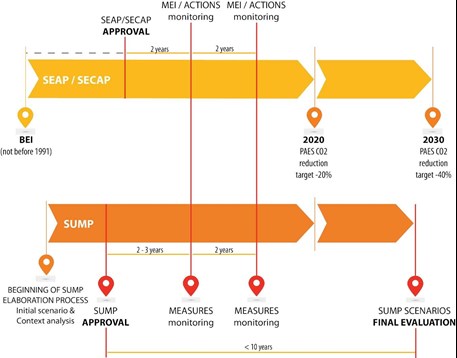Looking at the SUMP guidelines, Step 2.3.4 is closely related to Phase I ‘Preparing well’ - Step 1 ‘Determine your potential for a successful SUMP’ - Activity 1.5 ‘Define basic timeline’ and Step 2 ‘Define the development process and scope of plan’ - Activity 2.1 ‘Look beyond your own boundaries and responsibilities’ and Activity 2.4 ‘Agree on work plan and management arrangements’ as well as Phase III ‘Elaborating the plan’ - Step 8: Build Monitoring and assessment into the plan - Activity 8.1: Arrange for monitoring and evaluation.
The reference year is referred to as ‘baseline year’ in guidelines ‘How to develop a Sustainable Energy Action Plan Guidebook part 2’, and dealt with in chapter 2.1.
A SECAP provides for the definition of a baseline year to be used as the reference point to draw the Baseline Emission Inventory (BEI).
The baseline year could be much earlier than the SECAP’s approval year (suggest that it should be 1990 or - if the local authority does not have data to compile an inventory for 1990 - the closest subsequent year for which the most comprehensive and reliable data can be collected). A SUMP foresees instead the definition of a “state of the art” at the time of the plan initiation.
Once the baseline year has been selected, SECAPs aim at decreasing them by at least 40% by 2030.
The approach used in SUMPs is less defined. Each SUMP sets its time horizon to implement actions and achieve targets independently. Such time horizon is usually fixed at 10 years after the time of approval of the plan. Moreover, while SEAPs define the reduction of CO2 emissions as the only target, each SUMP defines its own set of objectives, indicators, approach for their definition and deadline for their achievement.
For example, it is possible to define the reduction of the use of private conventionally fuelled vehicles in favour of low carbon modes (public transport, cycling, walking etc.) as a specific objective and to define the related impact indicator in terms of modal split evolution (for example by increasing walking & cycling from 17% to 23% in 5 years).
SIMPLA suggests introducing in SUMPs also a 2020 or 2030 scenario, depending on whether the city has a or a SECAP, and defining also for the SECAPs a scenario in line with the SUMP timeframe. Drafting these scenarios could at first sight appear to be an unnecessary burden, yet this is the only way to achieve the harmonization and the comparability of both plans’ objectives as a prerequisite for the setting up of a joint monitoring procedure of results and the consequent revision of the plans’ objectives.
The SECAP monitoring procedures entail monitoring the achievements in two ways: every two years, at least the progress made by the actions should be assessed; every 4 years, besides monitoring the actions an update of the CO2 Monitoring Emissions Inventory – MEI is required (the MEI has the same structure of the BEI, but the data are referred to the most recent available data).
The SUMP guidelines suggest monitoring the progress made towards the achievement of the plan’s objectives every 1-5 years. The suggestion for harmonization is updating MEI and assessing the progress made by the SECAP actions every two years and revise SUMP objectives and actions at the same time, as shown in Figure 8:

Figure 8: Schedule for harmonized monitoring of SECAPs and SUMPs

